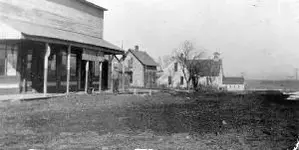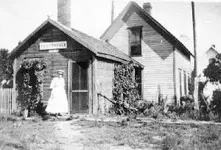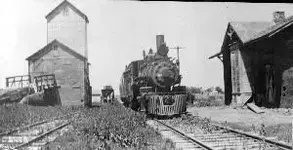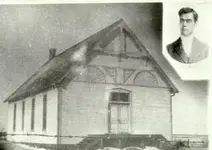Gypsy Heart
Gold Member
- #1
Thread Owner
Looks like a great place to hunt if permission is granted
Mina, a hamlet of Marshall county, is located in St. Bridget township, on the Missouri Pacific R. R., 20 miles northeast of Marysville, the county seat, and 6 miles from Summerfield. It has an express office and postoffice. The population in 1910 was 38.
After the railroad tracks were laid in 1887, a town was platted six miles south of Summerfield, where J. R. Sittler had built a warehouse in 1888 and bought grain.
A year later W. G. Wooley and Newman Erb laid out a town and named it Mina, for the wife of Sittler.
In 1894, farmers built a blacksmith shop and the horses were shod and wagons repaired by Albert Craig, the blacksmith.
Women's Lib was instituted early in the life of Mina where Miss Maggie lbert was the telegraph operator, and then postmaster following Rouse.
A wheel spoke design over the front door of the Christian Church, dedicated June 16, 1895, was the symbol that drew attention from a similar white boxlike structure, the Mina school that stood next door.
The McAtee home was second door to the general store, which was erected in 1890 by A. C. Axtell, after the construction of the passenger station, built in 1889.
During the heyday of farmer's cooperatives in the early half of the century, the Farmers Union operated the store with James Stirrat as store manager and B. C. Graham, overseer.
But as the railroad failed to survive, the town died and the brick depot was sold to Joe Holsan, Summerfield, who razed it,
As one who was born in the village and attended school and Sunday school there, the sentimental ties were bound to the memories of the building and McAtee purchased the schoolhouse and moved it to a farm one-half mile south of the site.
The town site returned to the land and Pat Reilly, Topeka, became the owner until 1972 when he sold it to Clarence and David Brown.
For 12 years Loyal McAtee farmed the land. As he plowed the town site, his memory returned to childhood days when he watched the arrival of the Kansas City and Northwestern train - the railroad which birthed the town and aborted it.
Mina, a hamlet of Marshall county, is located in St. Bridget township, on the Missouri Pacific R. R., 20 miles northeast of Marysville, the county seat, and 6 miles from Summerfield. It has an express office and postoffice. The population in 1910 was 38.
After the railroad tracks were laid in 1887, a town was platted six miles south of Summerfield, where J. R. Sittler had built a warehouse in 1888 and bought grain.
A year later W. G. Wooley and Newman Erb laid out a town and named it Mina, for the wife of Sittler.
In 1894, farmers built a blacksmith shop and the horses were shod and wagons repaired by Albert Craig, the blacksmith.
Women's Lib was instituted early in the life of Mina where Miss Maggie lbert was the telegraph operator, and then postmaster following Rouse.
A wheel spoke design over the front door of the Christian Church, dedicated June 16, 1895, was the symbol that drew attention from a similar white boxlike structure, the Mina school that stood next door.
The McAtee home was second door to the general store, which was erected in 1890 by A. C. Axtell, after the construction of the passenger station, built in 1889.
During the heyday of farmer's cooperatives in the early half of the century, the Farmers Union operated the store with James Stirrat as store manager and B. C. Graham, overseer.
But as the railroad failed to survive, the town died and the brick depot was sold to Joe Holsan, Summerfield, who razed it,
As one who was born in the village and attended school and Sunday school there, the sentimental ties were bound to the memories of the building and McAtee purchased the schoolhouse and moved it to a farm one-half mile south of the site.
The town site returned to the land and Pat Reilly, Topeka, became the owner until 1972 when he sold it to Clarence and David Brown.
For 12 years Loyal McAtee farmed the land. As he plowed the town site, his memory returned to childhood days when he watched the arrival of the Kansas City and Northwestern train - the railroad which birthed the town and aborted it.









